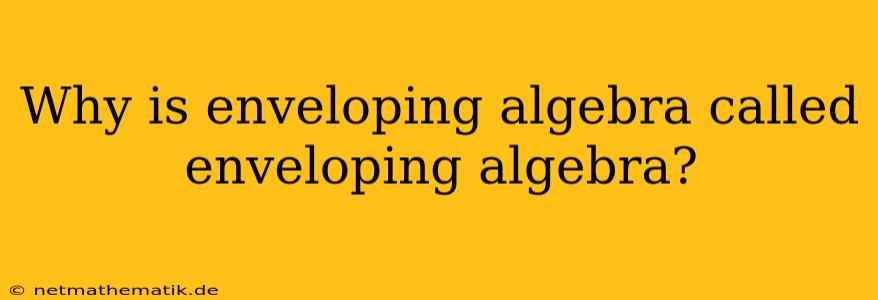The term "enveloping algebra" arises from its fundamental role in representing Lie algebras within the framework of associative algebras. This concept plays a crucial role in various areas of mathematics, particularly in representation theory and quantum mechanics. To understand why it's called "enveloping," we must delve into the construction and properties of this algebraic structure.
The Genesis of the Enveloping Algebra
Imagine a Lie algebra, which is a vector space equipped with a bilinear operation called the Lie bracket. This bracket satisfies certain properties, including skew-symmetry and the Jacobi identity. Lie algebras are powerful tools for studying symmetries and transformations. However, to fully understand their representation theory, we need a way to translate their structure into the language of associative algebras, which are more readily studied using techniques of linear algebra.
The enveloping algebra provides this translation. It's built from the Lie algebra itself, essentially "enveloping" it within a larger structure. The construction is as follows:
-
Tensor Algebra: We start with the tensor algebra of the Lie algebra. This is a space of formal linear combinations of elements obtained by taking tensor products of elements from the Lie algebra.
-
Ideal: We then define an ideal within this tensor algebra generated by the elements of the form
x ⊗ y - y ⊗ x - [x, y], wherexandyare elements of the Lie algebra, and[x, y]denotes their Lie bracket. -
Quotient: Finally, the enveloping algebra is defined as the quotient of the tensor algebra by this ideal.
The result is an associative algebra, denoted by U(g), where g is the original Lie algebra.
The Essence of "Enveloping"
The term "enveloping" aptly describes the relationship between the Lie algebra and its enveloping algebra:
-
Universal Property: The enveloping algebra possesses a universal property, meaning it's the "smallest" associative algebra containing a faithful representation of the original Lie algebra. This representation is obtained by mapping each element of the Lie algebra to its corresponding element in the enveloping algebra.
-
Embedding: The Lie algebra is essentially "embedded" within the enveloping algebra. It's like wrapping the Lie algebra in a larger, more flexible structure that preserves its essential algebraic properties while allowing for more general operations.
-
Representations: The enveloping algebra allows us to study representations of the Lie algebra. Since it's an associative algebra, its representations can be constructed using techniques from linear algebra. These representations can then be used to understand the symmetries and actions of the original Lie algebra.
Illustrative Example: The Heisenberg Algebra
Consider the Heisenberg algebra, a Lie algebra of dimension 3 with generators p, q, and h. Their Lie brackets are given by:
[p, q] = h[p, h] = 0[q, h] = 0
The enveloping algebra U(h) of the Heisenberg algebra can be thought of as the algebra of polynomials in p, q, and h, but with the commutation relation pq - qp = h incorporated. This relationship reflects the fundamental non-commutativity inherent in quantum mechanics.
The Significance of Enveloping Algebras
The concept of the enveloping algebra has profound implications in various fields:
-
Representation Theory: It's a crucial tool for studying representations of Lie algebras, which are essential for understanding symmetry groups in physics and mathematics.
-
Quantum Mechanics: Enveloping algebras of Lie algebras, such as the Heisenberg algebra, play a central role in the mathematical formulation of quantum mechanics. They provide a framework for describing the non-commutative nature of quantum observables.
-
Algebraic Topology: Enveloping algebras also appear in algebraic topology, where they're used to study the cohomology of Lie groups.
Conclusion
The term "enveloping algebra" accurately captures the essence of this mathematical construction. It envelopes a Lie algebra within a larger, more flexible associative algebra, preserving its crucial algebraic properties while providing a framework for exploring its representations and applications. Understanding this concept is fundamental for studying Lie algebras and their role in diverse areas of mathematics and physics.
